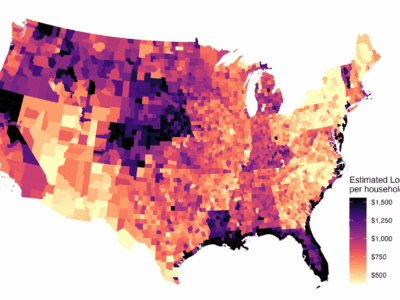Community Benefits Tools and Policy Drivers:
Select mechanisms can help ensure that energy projects deliver meaningful benefits for California communities
This is the third in a series of posts detailing CLEE’s new set of resources on Equitable Climate Infrastructure Investment.
Communities and local and state governments are increasingly turning to community benefits tools to support an equitable climate transition, catalyze substantive long-term investments in community priorities, and achieve effective, durable projects. CLEE’s new report, Community Benefits Tools and California Clean Energy Projects, analyzes select policy drivers and tools that can help deliver community benefits and explains the ways in which enforcement, benefits, and other factors differ between these mechanisms. The report also offers a comparison of four successful Community Benefits Agreements (CBAs) and highlights six principles necessary for meaningful CBAs.
Of the tools mentioned in the report, each may have various pros and cons from the community perspective, and some tools may be more appropriate for a particular community than others, depending on local conditions. (Other structures such as co-management may prove especially important for tribal peoples but are not discussed in this report.) Collectively, the tools and principles analyzed in CLEE’s new brief highlight the need for communities and allies to build the preconditions that will enable successful community benefits. Regional technical assistance hubs, discussed below, are one vehicle that can assist in realizing these critical preconditions.
Justice Principles
Energy justice & restorative justice principles (distributive justice, procedural justice, recognition justice, and restorative justice) can help contextualize these tools and ensure they deliver on community priorities in the fullest way possible. To ensure durable and meaningful benefits, clean energy projects & their community benefits provisions should be wrapped in these four principles of justice.
Policy Drivers for Community Benefits
A variety of policies and tools have emerged in California and other states to incorporate community benefits into clean energy projects and investments. CLEE’s report highlights two main categories: incentives and requirements.
Incentives include bidding credits (such as the bidding credits offered in BOEM’s California 2022 offshore wind auction) and ordinances or legislation (such as AB 205) that incentivize community benefits. Requirements include policies that require infrastructure projects to provide specific benefits (such as the CenterPoint Jobs Policies for operational jobs at the Port of Oakland’s Seaport Logistics Complex) and policies that require Community Benefits Agreements (CBAs) or federal Community Benefit Plans (CBPs) as part of projects (such as Sacramento’s proposed CBA ordinance). Each of these policy drivers has potential pros and cons, which should be weighed. Lastly, while government actors necessarily implement these policies, community coalitions can advocate for these mechanisms to jump-start government action.
Community Benefits Mechanisms and Tools
Select community benefits mechanisms and tools include Project Labor Agreements (PLAs); Community Benefits Plans; Host Community Agreements; Community Benefits Funds; and private Community Benefits Agreements (CBAs). These tools can be implemented by government, project developers, and/or community actors, depending on the instrument, and each tool possesses different possibilities for enforceability. PLAs, for example, are negotiated between developers or contractors and unions, while community benefits funds are often instigated by developers—although in some cases they can be structured to include community advisory boards. These various tools and mechanisms present different opportunities for community groups and advocates seeking to maximize the positive impacts and benefits of project investments.
Meaningful Private Community Benefits Agreements (CBAs)
Private Community Benefits Agreements (CBAs), one of many tools that communities can employ, have proved most successful when certain preconditions exist and when six principles are incorporated into the crafting of these agreements and into the agreements themselves.
The preconditions that a coalition, community group(s), and/or tribal community needs before the negotiation stage include:
-
- The technical expertise needed to properly understand the information that will be shared about the project and its impacts.
- The legal expertise needed to translate their vision for community benefits into an effective agreement.
- Other training, leadership development, and capacity-building assistance, such as an ability to understand the relevant permitting process(es), negotiating skills, and other topics.
Whether this capacity building and technical assistance emerges from the philanthropic sector, state government, industry, or other sources, the need for this support is urgent. Without it, California will not see the development of meaningful CBAs.
In addition, experts have identified six principals that contribute to beneficial CBAs. CBAs should be:
-
- Representative: Trusted community voices are represented in the negotiations.
- Transparent: The negotiations are transparent to those involved and to observing community members.
- Accountable: The CBA establishes measures to ensure the developer is accountable for meeting the CBA provisions.
- Enforceable: The CBA and its provisions are enforceable. Note that while legally enforceable contracts, the written agreement should be well constructed such that enforcement is possible.
- Impactful: The CBA produces substantive benefits over the long-term that the community wants and needs.
- Procedurally Fair: There is a fair process for decision-making. Also, impacted communities should be represented and possess adequate capacity to engage.
A CBA in and of itself is not a magic bullet for communities. The terms of the agreement are determined through negotiations, which is why the preconditions for success identified above are so critical. Furthermore, not all CBAs are community supporting (see e.g., the Atlantic Yards CBA). Accordingly, it behooves those interested in negotiating a CBA to strive toward and/or advocate for these six principals in both the negotiation process and the agreement itself.
Operationalizing community benefits tools
The non-exhaustive list of options presented in CLEE’s report can assist communities, tribal representatives, and others in identifying which tools are right for them. How-to guides, checklists, and other community resources also exist. For example, helpful guides from the US (such as resources from PowerSwitch Action, Riverwise, and Fair Shake Environmental Legal Services) and Canada (such as the First Nations LNG Alliance Guide and the Gordon Foundation’s IBA Community Toolkit) offer useful information and resources.
But in order for clean energy projects to deliver promised community benefits, communities, tribal representatives, and others will need more than information and toolkits—they will need sustained technical assistance (TA) and capacity building resources, as outlined in the preconditions for CBA success, above. Since TA funding for every community-based organization and tribal group in California is infeasible, decision-makers should consider regional technical assistance hubs as a solution. These hubs could be attached to neutral entities such as universities and could offer scientific, technical, and legal support for a variety of groups in a region. Maximizing resources and support for communities and tribal peoples through these hubs could help ensure that new climate investments incorporate principles of energy justice and restorative justice and result in long-term gains for communities. The community benefits tools listed in CLEE’s new report offer pathways toward community-beneficial projects, but they are much more likely to be meaningful, effective, and successful if communities and tribal peoples receive capacity building assistance and technical support in pursuing and implementing them.
The full report, Community Benefits Tools and California Clean Energy Projects, can be accessed here. For more detail on strategies for embedding community input in project design, including equity-oriented EV infrastructure development, please see CLEE’s report, Facilitating Equity-Oriented Electric Vehicle Infrastructure Investments: Strategies for Project Design.
Reader Comments
One Reply to “Community Benefits Tools and Policy Drivers:”
Comments are closed.







“…Communities and local and state governments are increasingly turning to community benefits tools to support an equitable climate transition…”
Please note that this article fails to list “climate mitigation” as a potential community benefit. Apparently the author is aware that there is no scientific research and no empirical data, which substantiate the actual real world atmospheric benefits that result from feeble attempts to mitigate climate change.
The combined effects of all the solar panels, wind turbines, EVs, green energy etc., throughout the whole world have not resulted in any reduction in average global atmosphere temperature whatsoever, not even a little bit.
The author is clever to protect her credibility by not mentioning climate mitigation. That’s progress.